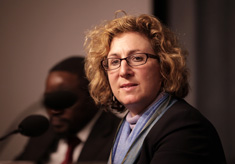-
Alison Brysk: Urbanization, Economic Change Hidden Drivers of Gender-Based Violence
February 28, 2014 By Paris Achenbach
Gender-based violence in developing countries is more than just a product of culture, war, extreme poverty, or historical patriarchy; it’s also a result of rapid economic change and urbanization, according to Alison Brysk, a fellow at the Wilson Center and the Mellichamp professor of global governance at the University of California, Santa Barbara.
Gender-based violence in developing countries is more than just a product of culture, war, extreme poverty, or historical patriarchy; it’s also a result of rapid economic change and urbanization, according to Alison Brysk, a fellow at the Wilson Center and the Mellichamp professor of global governance at the University of California, Santa Barbara.
“I think culture plays an important role, but I think there are some broadly-based features of patriarchy that change and morph over time,” Brysk says in this week’s podcast. “If we compare, for example, India, South Africa, Brazil, Mexico, these are countries that have very different cultural roots, and they’re all democracies…where the governance is troubled, but they’re not war zones and they’re not the poorest or most patriarchal.”
So why do they have some of the highest rates of gender-based violence? Brysk hazards a theory based on her recent studies: They’re all rapidly developing and urbanizing. “There’s a dynamic process here,” she says. “It’s not just the static features, it’s not just, for example, poverty; it’s economic change, it’s inequality.”
Brysk argues that crowding, resource competition, and breakdowns in urban governance fuel violence against women, as well as high levels of inequality and rapidly shifting gender roles. “It’s not just how urban a country is, it’s whether there’s a process of urbanization. Social change tends to be a driver and a tipping point for conflict and violence of all kinds.”
Understanding the drivers of gender-based violence is only becoming more important as rates and intensity appear to be rising in some parts of the world. Mexico, for example, has witnessed an “increasing use of weapons in sexual assault,” and in Africa and India, there are more reports of gang rape and assaults on children, she said. Likewise, reported cases of sexual violence have increased 150 percent over the past five years in Brazil, and 14.8 percent of women report they’ve been sexually abused in their homes in India, which, she points out, is 60 million women minimum.
How to reverse this disturbing trend is far from clear. “What we need is to assess what we’re finding out about drivers, and where the interventions are, and really do a better job about which interventions are going to get at which of these factors,” Brysk says.
Alison Brysk spoke at the Wilson Center on February 18. Download her slides to follow along.
Friday podcasts are also available for download on iTunes.
Topics: Africa, Brazil, conflict, demography, development, economics, Friday Podcasts, GBV, gender, India, Latin America, Mexico, podcast, poverty, security, South Africa, urbanization
 A Publication of the Stimson Center.
A Publication of the Stimson Center.




